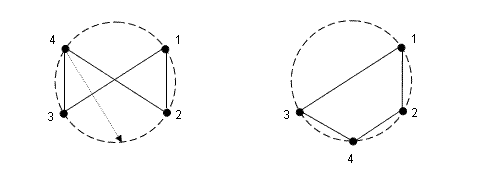当前你的浏览器版本过低,网站已在兼容模式下运行,兼容模式仅提供最小功能支持,网站样式可能显示不正常。
请尽快升级浏览器以体验网站在线编辑、在线运行等功能。
2403:Human Knot
题目描述
A classic ice-breaking exercise is for a group of n people to form a circle and then arbitrarily join hands with one another. This forms a "human knot" since the players' arms are most likely intertwined. The goal is then to unwind the knot to form a circle of players with no arms crossed.
We now adapt this game to a more general and more abstract setting where the physical constraints of the problem are gone. Suppose we represent the initial knot with a 2-regular graph inscribed in a circle (i.e., we have a graph with n vertices with exactly two edges incident on each vertex). Initially, some edges may cross other edges and this is undesirable. This is the "knot" we wish to unwind.
A "move" involves moving any vertex to a new position on the circle, keeping its edges intact. Our goal is to make the fewest possible moves such that we obtain one n-sided polygon with no edge-crossings remaining.
For example, here is a knot on 4 vertices inscribed in a circle, but two edges cross each other. By moving vertex 4 down to the position between 2 and 3, a graph without edge-crossings emerges. This was achieved in a single move, which is clearly optimal in this case.

When n is larger, things may not be quite as clear. Below we see a knot on 6 vertices. We might consider moving vertex 4 between 5 and 6, then vertex 5 between 1 and 2, and finally vertex 6 between 3 and 4; this unwinds the knot in 3 moves.

But clearly we can unwind the same knot in only two moves:

We now adapt this game to a more general and more abstract setting where the physical constraints of the problem are gone. Suppose we represent the initial knot with a 2-regular graph inscribed in a circle (i.e., we have a graph with n vertices with exactly two edges incident on each vertex). Initially, some edges may cross other edges and this is undesirable. This is the "knot" we wish to unwind.
A "move" involves moving any vertex to a new position on the circle, keeping its edges intact. Our goal is to make the fewest possible moves such that we obtain one n-sided polygon with no edge-crossings remaining.
For example, here is a knot on 4 vertices inscribed in a circle, but two edges cross each other. By moving vertex 4 down to the position between 2 and 3, a graph without edge-crossings emerges. This was achieved in a single move, which is clearly optimal in this case.

When n is larger, things may not be quite as clear. Below we see a knot on 6 vertices. We might consider moving vertex 4 between 5 and 6, then vertex 5 between 1 and 2, and finally vertex 6 between 3 and 4; this unwinds the knot in 3 moves.

But clearly we can unwind the same knot in only two moves:

输入解释
The input consists of a number of cases. Each case starts with a line containing the integer n (3 <= n <= 500), giving the number of vertices of the graph. The vertices are labelled clockwise from 1 to n. Each of the next n lines gives a pair of neighbors, where line i (1 <= i <= n) specifies the two vertices adjacent to vertex i. The input is terminated by n = 0.
输出解释
For each case, if there is no solution, print "Not solvable." on a line by itself. If there is a solution, print "Knot solvable." on a line by itself, followed by the minimum number of moves required to solve the problem, on a line by itself.
输入样例
6 4 5 3 5 2 6 1 6 1 2 3 4 6 2 6 1 4 5 6 2 5 3 4 1 3 0
输出样例
Knot solvable. 2 Knot solvable. 1
来自杭电HDUOJ的附加信息
| Recommend | lcy |
最后修改于 2020-10-25T22:53:08+00:00 由爬虫自动更新
共提交 0 次
通过率 --%
| 时间上限 | 内存上限 |
| 5000/2000MS(Java/Others) | 32768/32768K(Java/Others) |
登陆或注册以提交代码